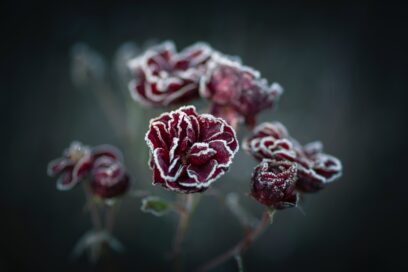You have no items in your cart. Want to get some nice things?
Go shopping1 minute read.

I sit inside, watching the flicker of fewer apple and lime green maple leaves, the swing and sway of branches dangling more bronze and copper and scarlet and gold, swirls of confetti that drift before becoming silent cyclones on sidewalks. The turning of the seasons came very late this year, after eighty-degree days in October, its roundness full of warmth and abundance, the glow of its pumpkin harvest moon. The week before Halloween, the sun sunk into the clouds and chill gray rain fell with a drip and a droop but little drama. Our first frost arrived a few days later.
Growing up in California, I used to think that frost would be this amazing, silver-laced event, when delicate ferny patterns would cover windows and we would sip hot chocolate by the fire. It’s not like that. The frost is the hard no, a brutal and bruising butchering, the slaughtering of summer.
I linger inside. Just because the trees shimmer with golden, tawny warmth doesn’t mean it’s not cold. Eventually I haul myself out of the nest of blankets on the couch and fumble into my jacket and gardening gloves. Even at noon, the garden is in shade, the trees marble in a cold museum. The sunlight filters through like weak lemonade, watered-down and withered, seeping over the sleeping.
I start with the dahlias on the south side. They got up to five feet tall this year, pink as blush wine, on big, thick stalks. I can see them here, just a few weeks ago. Now they are bloated, blackened, browned. The little ones are mushy. I snip off the plant, leaving the bulbs tucked under the ground. It’s always a risk if they will come back or if the hollow, exposed stem will cause the bulb to rot. I move to the peach ones.
They were just here, these dahlias, the jewels of July, raspberry and merlot, and my favorite pink ones, striped with rose and apricot, standing tall.
I pull my salmon and coral zinnias from the ground, soil clinging to their roots, shaken free and separated. Their spines are stiffened in protest, an unhealthy shade of gray green. I clip back my marigold, planted in such a tough spot, surviving all summer even though I dug only a shallow hole in stony ground. Its little claws clutched what it could reach, and always a little more. I cut its baby-bird skeleton, pale and bloomless.
These were all just alive, all just here, a few short weeks ago. More frosts will come. For now, my blanket flowers and salvias are spared. Just the tender ones were taken.
Tucked into the soil, put in on the last warm afternoon, are my daffodils. And soon, I will scatter poppy seeds. They need the cold to stratify so they can bloom. I know these things, in November, just as I know the hard no of the frost. I know the story has a happy ending, that resurrection begins in the dark, that renewal returns.
But this afternoon, in the cold golden light, I wonder where my zinnias went. They brought me such joy. I remember my French marigold. I think of my beloved dahlias, the belles of the ball, full in their flouncing skirts, overflowing.
I don’t know where they went. They were all just here.
Heather Bartos
Heather Bartos writes both fiction and nonfiction. Her most recent essays have been published in McNeese Review, The Tiny Journal, Arboreal, and Instant Noodles. She’s also had flash fiction and micro fiction in The Baltimore Review, Orca, and The Closed Eye Open, and other publications, and short stories in Ponder Review, Bridge Eight, Relief: A Journal of Art and Faith, and elsewhere. She is working on a master’s in fine arts through the University of New Orleans.




